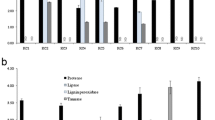Summary
The luminous bacteriaVibrio harveyi andV. fischeri degrade cellulose. Cellulase activity was high when carboxymethyl cellulose and cellobiose were used as substrates but low with cellulose powder. The role of these microbes in the digestion of food material in fish gut is also discussed.
Résumé
Les bactéries lumineusesVibrio harveyi etV. fischeri dégradent la cellulose. L'activité cellulolytique était élevée lorsque la carboxméthylcellulose et la cellobiose servaient de substrats, mais elle était faible avec la poudre de cellulose. On discute également de rôle de ces microorganismes dans la digestion du matériau alimentaire.
Resumen
Las bacterias luminosasVibrio harveyi yV. fischeri degradan celulosa. La actividad celulásica fue alta cuando se utilizó Carboxy-metil-celulosa o celobiosa como sustrato y baja cuando se utilizó polvo de celulosa. Se discute el papel de estos microorganismos en la digestión intestinal de los alimentos en peces.
Similar content being viewed by others
References
Araki, T. &Kitamikado, M. 1978 Distribution of mannan-degrading bacteria in aquatic environments.Bulletin of Japanese Society of Scientific Fisheries 44, 1135–1139.
Fukasawa, S., Dunlap, P.V., Baba, M. &Osumi, M. 1987 Identification of an agar-digesting, luminous bacterium.Agricultural and Biological Chemistry 51, 265–268.
Hamid, A., Sakata, T. &Kakimoto, D. 1979 Microflora in the alimentary tract of gray mullet-Estimation of enzymic activities of the intestinal bacteria.Bulletin of Japanese Society of Scientific Fisheries 45, 99–106.
Ishida, J. 1935 The stomach ofMugil cephalus and its digestive enzymes.Annot Zool Japan 15, 183–189.
Morinaga, T., Araki, T., Ito, M. &Kitamikado, M. 1981 A search for fucoidan degrading bacteria in coastal sea environments of Japan.Bulletin of Japanese Society of Scientific Fisheries 47, 621–625.
Nelson, N. 1944 A photometric adaptation of the Somogyi method for the determination of glucose.Journal of Biological Chemistry 153, 375–380.
Payne, D.W., Thorpe, N.A. &Donaldson, E.M. 1972 Cellulolytic activity and a study of the bacterial population in the digestive tract ofScrobicularia plana (Dacosta).Proceedings of the Malacological Society of London 40, 147–160.
Ramesh, A. 1986 Ecophysiological studies on luminous bacteria of Vellar Esutary. Ph.D thesis, Annamalai University, India.
Reese, E.T., Sill, R.G.H. &Levinson, H.S. 1950 The biological degradation of soluble cellulose derivatives and its relationship to the mechanism of celulose hydrolysis.Journal of Bacteriology 59, 485–497.
Somogyi, M. 1952 Notes on sugar determination.Journal of Biological Chemistry 195, 19–23.
Stickney, R.R. &Shumway, S.E. 1974 Occurrence of cellulose activity in the stomachs of fishes.Journal of Fish Biology 6, 779–790.
Author information
Authors and Affiliations
Rights and permissions
About this article
Cite this article
Ramesh, A., Venugopalan, V.K. Cellulolytic activity of luminous bacteria. Mircen Journal 4, 227–230 (1988). https://doi.org/10.1007/BF01301952
Received:
Revised:
Accepted:
Issue Date:
DOI: https://doi.org/10.1007/BF01301952




